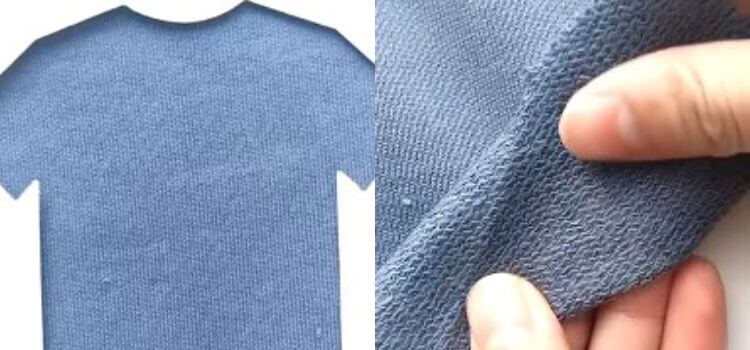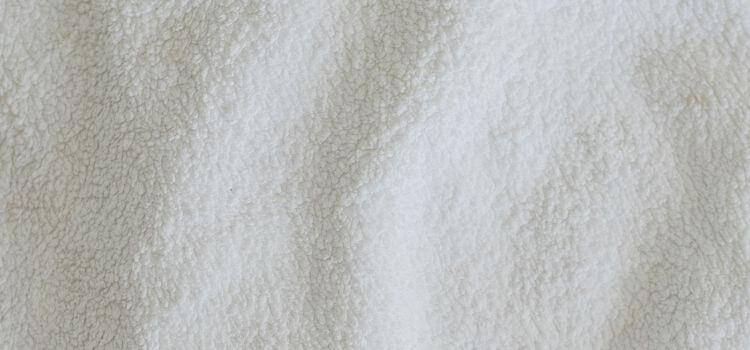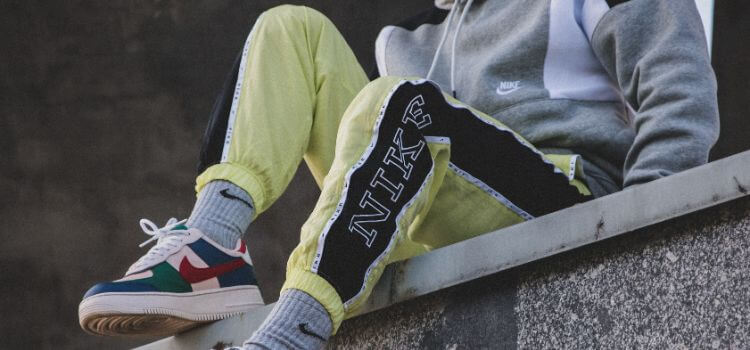If you buy via any of our links, there will be no additional cost to you, and we will receive a tiny commission. More information is available on our Affiliate Disclosure page.

What is French Terry Made of?
What is French Terry Made Of? French Terry is made of 100% cotton or a cotton-polyester blend. It is a soft, moisture-wicking fabric with looped piles on one side, common in casual clothing, sportswear, and loungewear.
Sweatshirts, hoodies, and lounge pants are common examples of this fabric. This adaptable and popular material has swept the fashion world, offering the ideal blend of comfort, style, and functionality.
But have you ever wondered what makes it unique and what separates it from other fabrics?
In this in-depth look at French Terry, we will see its composition, manufacturing process, and the reasons for its widespread popularity.
Whether you’re a fashionista or just curious about the fabrics you wear, join us on this journey to discover the wonders of French Terry and why it’s a wardrobe staple for people of all ages.

What is French Terry Material?
Its unique texture and comfort make it a popular and versatile knitted fabric. It’s a variation on terry cloth, a woven fabric traditionally used for towels, but it takes it to another level.
This fabric has loops and soft piles on one side and is smooth and flat on the other.
This usually consists of cotton or a blend of polyester or spandex. This is a popular choice for clothing for physical activities or lounging because it is breathable and absorbent.
The addition of synthetic fibers improves the fabric’s stretch, durability, and shape retention, ensuring its quality even after many washes and wears.
The unique moisture-wicking qualities make it ideal for activewear and sportswear. The internal loops of the fabric absorb and disperse moisture effectively, keeping the body dry and comfortable during workouts.
This lightweight fabric has come into many clothing items, including sweatshirts, hoodies, joggers, dresses, and even accessories like beanies.
Its versatility allows for easy incorporation into many styles, from casual to athleisure, and its cozy feel against the skin makes it an excellent choice for loungewear.
French Terry fabric is a popular choice for those looking for fashionable comfort in their clothing. Its cotton and other fiber blend, combined with moisture-wicking properties, has made it a favorite among fashionistas and activewear enthusiasts.

What is French Terry?
It is a knit fabric that differs from traditional woven cloth. This fabric is by looped piles on one side while remaining flat and smooth on the other.
Cotton’s breathability makes it an excellent choice for active and leisure clothing. The addition of synthetic fibers improves the fabric’s stretch and durability, ensuring that it keeps its shape and quality even after repeated washings.
The exceptional moisture-wicking qualities of the fabrics are one of its strengths. The inside loops of the material absorb moisture efficiently, keeping the wearer dry and comfortable during workouts or on hot days.
This soft and lightweight fabric has numerous uses in the fashion industry. It is the best material to make stylish and comfortable activewear such as sweatshirts, hoodies, joggers, and athleisure wear.
Because of its cozy feel against the skin, it’s also a popular choice for loungewear and casual clothing.
This is a knit fabric famous for its looped texture and moisture-wicking properties. Because of its comfort and versatility, it become a favorite among those looking for fashionable yet functional clothing for many activities and occasions.
what is French Terry Fabric Used For?


Cloth
French Terry cloth is primarily made of cotton, but it may also mix with other materials such as polyester or spandex.
French Terry’s signing softness and coziness come from the loops on the inside of the fabric, making it a popular choice for comfortable and casual clothing.
It’s popular for activewear, loungewear, and athleisure because of its moisture-wicking properties, which help keep the body dry during physical activities.
Because of its ventilation and absorbency, this fabric is ideal for hundreds of weather conditions, providing both comfort and style. These fabrics include T-shirts, polo shirts, sweatshirts, hoodies, sweatpants, joggers, shorts, and other clothing items.
This is a popular fabric among those who want to wear outfits that are comfortable and fashionable.
It has become a fashion industry staple due to its softness, moisture-wicking capabilities, and ease of care, catering to your lifestyle needs and preferences.
This is a popular sweatshirt and hoodie fabric. Its soft and cozy inside makes it ideal for staying warm during workouts or on chilly days.
Joggers and lounge pants made of these fabrics are ideal for style and comfort. Because of the fabric’s stretchability, they are great for exercising and lounging at home.
Dresses and skirts made of this are becoming increasingly popular in casual and athleisure wear. They provide a relaxed and fashionable appearance while remaining comfortable throughout the day.
Many activewear sets, particularly those designed for yoga or light workouts, feature this fabric. These sets frequently include matching tops and bottoms for a coordinated and stylish look.
This is even used to make accessories like beanies and headbands. These items are equally fashionable while functional.
This is another popular fabric for children’s clothing. Its softness and breathability make it gentle on young skin, and its ability to withstand active play makes it a popular choice among parents.
It is frequently used to create lightweight hooded jackets that are both fashionable and functional. These jackets are ideal for layering and providing warmth in cold weather.
Let’s explore some of the popular garments made from the fabric:
T-Shirt:
A T-shirt in it provides a casual yet chic look. It is a lightweight and breathable fabric for everyday wear.
Polo:
The polo combines the classic look of a polo shirt with the comfort of this fabric. It’s ideal for a sporty yet refined look.
Sweatshirt:
The classic sweatshirt is a wardrobe essential. Its inside looped texture provides warmth and coziness, making it ideal for cooler days.
Crewneck Sweatshirt:
The crewneck variant, like the sweatshirt, has a rounded neckline, which adds a touch of casual elegance to the design.
Sweatpants:
These sweatpants are the height of luxury. They are ideal for lounging, working out, or running errands in comfort and style.
Pants:
These pants have a more tailored and sophisticated appearance than sweatpants. Depending on the occasion, you can get dressed up or down.
Joggers:
These joggers are popular for athletic and casual wear because they combine comfort and style.
Shorts:
These shorts are a breathable and relaxed option for staying comfortable and stylish on warmer days.
Hoodie:
The hoodie is essential for staying warm and fashionable. It’s great for wearing as a layer or on its own.
Zip-Up Hoodie:
The zip-up variant provides the same comfort as a traditional hoodie but allows easy wear and removal, making it versatile and practical.
Cardigan:
A cardigan is a lightweight layer of warmth ideal for transitioning between seasons.
Sweater:
These sweaters are stylish and comfortable, providing a great look while keeping you warm during the cooler months.


These fabrics are extremely versatile and are used to create clothing items suitable for many occasions and activities.
Whether it’s activewear, loungewear, or casual fashion, French Terry’s comfort and performance qualities have made it a staple in modern clothing design.
When should I Wear French Terry?
You can wear French Terry fabric for any event and different occasions, and great for its comfort, versatility, and style.
Here are some specific occasions when wearing This clothing is especially appropriate:
Lounging at Home:
This is ideal for relaxing at home, providing a comfortable and cozy atmosphere. Loungewear such as joggers, sweatshirts, and hoodies are great for watching TV, reading a book, or relaxing.
Casual Outings:
This clothing is a great choice for looking effortlessly stylish while feeling at ease. Pairing t-shirts, shorts, or joggers with a fashionable top creates a relaxed and fresh look.
Workouts and Physical Activities:
This is an excellent choice for athletic wear. Sweatshirts, sweatpants, and joggers made of this fabric are ideal for workouts, yoga, and gym trips.
Outdoor Adventures:
In cool, unpredictable weather, French Terry layers like hoodies or zip-up jackets provide warmth and breathability for outdoor activities.
Traveling:
When traveling, comfort is essential, and these outfits allow you to move freely while still looking neat.
Transitioning Seasons:
As the seasons change, these cardigans and lightweight sweaters provide the best of warmth and breathability.
Relaxed Social Gatherings:
This clothing is an excellent option for casual social events or gatherings where you want to feel comfortable without sacrificing style.
Casual Fridays at Work:
This clothing is a great choice for casual social events or get-togethers with friends where you want to feel comfortable without sacrificing style.

Remember that these fabrics are available in many styles and designs, so you can identify options that fit your tastes and the particular occasion.
It provides the ideal combination of comfort and fashion for many situations in your daily life, whether it’s a relaxed day at home, a workout session, or a casual outing.
Does French Terry keep you warm?
These fabrics can keep you warm, particularly in mild to cool weather. The inside loops of the fabric create a soft and plush texture that traps body heat, providing insulation and keeping you warm.
These clothing, such as sweatshirts, hoodies, and sweaters, have a looped texture that acts as a barrier to keep warmth close to your body.
While it isn’t as heavy or thick as some winter fabrics like wool or fleece, it provides a comfortable level of warmth for activities and temperatures that don’t necessitate heavy outerwear.
It’s perfect for layering during transitional seasons like spring or fall when the weather can be cool but not cold.
The moisture-wicking properties of these fabrics play a significant role in keeping you warm. It efficiently absorbs and disperses moisture away from your body as you engage in physical activities or experience temperature changes. This feature keeps the fabric from becoming damp.
Layer clothing with additional outerwear, or use it as a layered outfit for maximum warmth in extreme cold.
The fabric is perfect for comfort and moderate warmth in wintertime, making it ideal for casual wear, lounging, and light physical activities.
Is French Terry Fabric for Winter or Summer?
The fabric is appropriate for the winter and summer seasons. It is also a good option for many weather conditions.
The unique properties of the fabric contribute to its ability to adapt to different temperatures:
Winter:
This is a popular choice for winter clothing for its soft and looped texture on the inside. The loops form an insulation layer that traps body heat, providing warmth and comfort in cooler weather.
These sweatshirts, hoodies, and sweaters are popular for keeping warm on cold days. It is ideal for layering under jackets or coats during the colder months to add extra warmth.
Summer:
Even though it is a hot and insulating fabric, it works well for use in the summer. The key is the breathability and moisture-wicking properties.
The inside fabric loops absorb and disperse moisture away from the body, keeping you dry and comfortable in hot and humid weather.
These t-shirts, shorts, and tank tops are great options for casual summer outfits because they are stylish and functional.
Transitional Seasons:
This is ideal for shifting seasons like spring and fall when the weather can be unpredictable. Its ability to provide moderate warmth while remaining lightweight makes it an excellent choice for these changing seasons.
When selecting clothing for specific seasons, it is required to consider the weight and thickness of the fabric.
Find slightly thicker and heavier French Terry garments for winter and lighter and more breathable options for summer.
The French Terry fabric is flexible for winter, summer, and transitional months. Its adaptability, comfort, and style make it a popular year-round fashion choice.
Does French Terry Wrinkle?
Although this fabric is less prone to wrinkling than other fabrics, it can still develop wrinkles, especially after washing and drying.
Several factors affect the level of French Terry wrinkles, including fabric composition, weight, and care taken during washing and drying.
Cotton-based French Terry fabrics wrinkle more easily than those blended with synthetic fibers such as polyester or spandex.
Cotton fibers naturally crease, which can result in wrinkling. The synthetic fibers in the blend can help minimize wrinkling and boost the fabric’s resilience.
The weight of the fabric also influences its wrinkling resistance. Thicker and heavier French Terry may be less prone to wrinkles than thinner and lighter forms.
How to Care? Is it Simple to Clean French Terry?
French Terry fabric is generally simple to clean and maintain, making it an appealing option for everyday wear.
The ease of cleaning can vary depending on the specific care guidelines and fabric composition.
Here is some general cleaning advice for French Terry clothing:
Follow Care Instructions:
Always check the care label on your French Terry garment. Various clothes or blends need different requirements. So, please follow the maker’s recommendations.
Machine Washable:
Most French Terry clothing is machine washable, which adds to its convenience. To avoid excessive agitation, use a gentle or delicate cycle.
Cold Water Wash:
Washing French Terry in cold water helps to preserve the color and prevents shrinking. It also uses less energy than hot water washes.
Use Mild Detergent:
Use a mild detergent to avoid toxic chemicals that can harm the fibers or irritate your skin.
Avoid Bleach:
Avoid using bleach or harsh stain removers on French Terry because they may ruin the fabric and reduce its softness.
Inside Out:
Before washing, turn the garment inside out to help protect the outer surface while keeping its original look.
Dry Flat or Tumble Dry Low:
Air dry your French Terry clothing flat to keep its shape. Use a dryer on a low or soft heat setting to prevent too much shrinkage or fabric damage.
Avoid High Heat Ironing:
If ironing is required, use a low heat setting and avoid direct contact with the looped side of the fabric to keep from flattening the loops.
While French Terry is generally easy to clean, it’s mandatory to deal with stains quickly and follow the care instructions to keep the fabric’s quality and lifespan. Proper care and washing will keep your French Terry clothing looking and feeling new for a long time.
Why is French Terry so Pricey?
Due to several factors that impact its making and standards, French Terry can sometimes be more expensive than other basic knit fabrics.
Here are some of the reasons why French Terry might be more expensive:
Fabric Composition
French Terry fabric is a blend of cotton, polyester, and spandex. These synthetic fibers, particularly high-quality ones, may affect production costs.
Manufacturing Way
French Terry goes through an intricate knitting process using specialized machines. Creating a looped texture on one side while keeping a smooth surface on the other requires precise techniques, which can increase manufacturing costs.
Softness and Comfort:
French Terry is known for its elegant feel and softness. Since the use of higher-quality materials and advanced processing techniques, fabrics that provide outstanding comfort tend to be more expensive.
Moisture-Wicking Properties:
French Terry’s moisture-wicking properties, which make it ideal for activewear, necessitate specific treatments during production, which adds to the overall cost.
Durability and Longevity:
French Terry is more durable, allowing it to withstand frequent wear and washing. This emphasis on longevity may raise the price because it requires more powerful and durable fibers.
Fashion and Demand:
French Terry’s popularity in the fashion industry, and its use in creating equally casual and athleisure wear, drive up demand for this fabric, which can result in higher prices.
Brand and Quality:
The image of the brand, plus the overall quality of the fabric, plays an important role in figuring out the price. French Terry products from designer brands or those known for superior quality may be priced higher.
Ethical and Sustainable Practices:
Manufacturers who choose environmentally friendly practices, like eco-friendly dyes or organic materials, may incur higher production costs, reflected in the final price of French Terry products.
French Terry fabric costs more because of factors including fabric design, specialized processing, beneficial features, longevity, style buyer demand, company image, and ethical considerations.
Despite the higher price label, many consumers are willing to invest in French Terry because of its luxurious feel, durability, and flexibility in creating stylish and cozy clothing.
Which Materials are Similar to French Terry?
In the sense of texture, comfort, and flexibility, several materials are similar to French Terry. These materials come in handy to make clothing similar to French Terry.
Some of the closest alternatives are as follows:
Terry Cloth
Terry cloth, as the name shows, is related to French Terry. Like French Terry, it is a woven fabric with looped piles on one or both sides. Terry cloth is heavier and more absorbent, making it ideal for towels and bathrobes.
Jersey Knit
Jersey knit is a lightweight, smooth fabric made from single-knit manufacturing. While it lacks the looped texture of French Terry, it has the same stretch and softness, making it appropriate for casual wear and basic t-shirts.
Sweatshirt Fleece
A knit fabric with a brushed and soft interior that offers a cozy and warm feel similar to French Terry. It’s trendy for sweatshirts and hoodies and a great choice for cooler weather.
Modal
Modal is a rayon made from beech tree fibers known for its silky, soft, and breathable qualities. Without a loop like French Terry, it still offers the same level of comfort and drape, making it popular for casual and loungewear.
French Terry Blend
Some fabrics are to resemble French Terry by combining various materials to achieve similar properties. Cotton-polyester or spandex blends, for example, may provide moisture-wicking and softness, similar to French Terry.
Bamboo Terry
Bamboo terry is a fabric made of bamboo fibers with a soft and absorbent texture similar to French Terry. It’s popular for towels, baby clothes, and bathrobes.
While these materials are similar to French Terry, each has its characteristics and uses. When looking for a fabric, such as moisture-wicking, warmth, or soft, be sure the clothing meets your requirements.
What is the difference between French Terry fabric and terry cloth?
French Terry fabric is a knit fabric with looped piles on one side, whereas terry cloth is a woven fabric with loops on both sides that is common for towels.
Is French Terry fabric appropriate for both winter and summer clothing?
Because of its versatility and moisture-wicking properties, French Terry fabric is appropriate for both winter and summer wear.
Why is French Terry more expensive than other knit fabrics?
Because of the fabric composition, manufacturing process, comfort, and demand in the fashion industry, it is now more expensive.
How do I care for and clean French Terry clothing?
French Terry clothing is generally simple to clean. Machine wash in cold water with mild detergent, and air dry or tumble dry low.
Are there other materials similar to French Terry’s comfort and texture?
Yes, terry cloth, jersey knit, sweatshirt fleece, modal, and bamboo terry are all similar to French Terry.
Does the French Terry fabric wick away moisture?
Yes, French Terry is moisture-wicking and will keep you dry during physical activities.
Can you machine wash French Terry fabric?
Yes, most French Terry fabrics are machine washable.
What factors should I take when deciding between French Terry and other knit fabrics for my clothing?
When deciding between French Terry and other knit fabrics, consider comfort, style, care instructions, and specific requirements.
Is French Terry fabric appropriate for workouts and activewear?
Because of its comfort and moisture-wicking properties, French Terry is appropriate for activewear and workouts.
How can I keep my French Terry clothing from getting wrinkled?
Follow care instructions, remove clothes promptly after washing, and fold or hang them neatly to avoid wrinkles.
Finally,
French Terry fabric is versatile and popular because of its unique looped texture on one side and smooth finish on the other. This knit fabric is best for multiple weather conditions and activities because it combines comfort, style, and functionality.
French Terry is a popular fabric for winter and summer wear, providing warmth in the cooler months and excellent moisture-wicking features in hot and humid conditions. Its softness and absorbency, combined with its air circulation, ensure a comfortable experience in many situations.
The fabric’s popularity in the fashion industry, and its adaptability to different clothing styles, contribute to its increased demand and cost. The quality, durability, and luxurious feel make the investment beneficial.
Cleaning and caring for French Terry clothing is simple, with machine-washable options and simple care instructions to ensure the fabric’s longevity.
Furthermore, similar materials to French Terry, like terry cloth, jersey knit, and sweatshirt fleece, offer comparable comfort and texture, allowing individuals to explore wardrobe options.
French Terry fabric is a wise and justified choice for making a wide range of clothing items, from casual loungewear to stylish activewear. Its comfort, moisture-wicking properties, and ease of care make it a favorite among fashion-conscious individuals who want to combine features and fashion in everyday wear.

